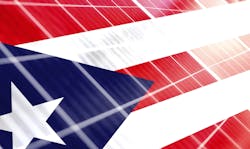DOE releases $450M+ to fund Residential Solar-Battery Storage for Puerto Rico
The investment to create energy resiliency in Puerto Rico gained another lift this week when the U.S. Department of Energy announced more than $450 million in funding released for increasing residential rooftop solar and battery storage, which can be organized into microgrids, on the island territory.
The money, coming from the federal government's Puerto Rico Energy Resilience Fund (PR-ERF), will focus on projects across Puerto Rico, particularly the most vulnerable residents there. Puerto Rico’s main grid has been severely damaged multiple times by hurricanes across the region.
“A future powered by renewables will offer the residents of Puerto Rico more energy security and more reliability—all while leaving households with cheaper bills to pay,” DOE Secretary Jennifer Granholm said in a statement.
The PR-ERF was established earlier this year. Many private-industry solar and battery storage packages are built at little or no upfront cost to the recipient, thanks to funding help by the federal government, and residents are billed monthly for their energy use.
A decentralized grid, sometimes a microgrid, are considered as viable options to the main system in which transmission and distribution lines cover significant distance and are vulnerable to weather events. Some hurricanes have completely knocked out transmission lines, severing the connection between customer and power plant generation.
Hurricane Fiona last year brought Category 4 winds and more than 20 inches of rain to Puerto Rico. On Sept. 18, the storm caused an island-wide power outage.
In 2017, Hurricane Maria was a Category 5 storm with ferocity that basically destroyed much of Puerto Rico’s already aged grid infrastructure. It followed an equally devastating Hurricane Irma by only two weeks.
The Puerto Rico Energy Resiliency Fund, established with at least $1 billion, seeks a goal of achieving renewable energy for 100 percent of the island by 2050. The latest $450 million funding release aims for solar and battery installations at up to 40,000 residential sites, with a particular focus on low-incomes residences.
Microgrids can be created utilizing this on-site power installations via control technologies. Earlier this year. The U.S. Federal Emergency Management Agency approved more than $10 million for a separate program installing solar microgrids in Puerto Rico.
Cooperatives are installing microgrids in the central and mountainous Cordillera Central region of Puerto Rico. The Cooperativa Hidroelectrica de la Montana plans to create about 30 solar microgrids there.
About the Author
Rod Walton, Microgrid Knowledge Head of Content
Managing Editor
For Microgrid Knowledge editorial inquiries, please contact Managing Editor Rod Walton at [email protected].
I’ve spent the last 15 years covering the energy industry as a newspaper and trade journalist. I was an energy writer and business editor at the Tulsa World before moving to business-to-business media at PennWell Publishing, which later became Clarion Events, where I covered the electric power industry. I joined Endeavor Business Media in November 2021 to help launch EnergyTech, one of the company’s newest media brands. I joined Microgrid Knowledge in July 2023.
I earned my Bachelors degree in journalism from the University of Oklahoma. My career stops include the Moore American, Bartlesville Examiner-Enterprise, Wagoner Tribune and Tulsa World, all in Oklahoma . I have been married to Laura for the past 33-plus years and we have four children and one adorable granddaughter. We want the energy transition to make their lives better in the future.
Microgrid Knowledge and EnergyTech are focused on the mission critical and large-scale energy users and their sustainability and resiliency goals. These include the commercial and industrial sectors, as well as the military, universities, data centers and microgrids. The C&I sectors together account for close to 30 percent of greenhouse gas emissions in the U.S.
Many large-scale energy users such as Fortune 500 companies, and mission-critical users such as military bases, universities, healthcare facilities, public safety and data centers, shifting their energy priorities to reach net-zero carbon goals within the coming decades. These include plans for renewable energy power purchase agreements, but also on-site resiliency projects such as microgrids, combined heat and power, rooftop solar, energy storage, digitalization and building efficiency upgrades.

